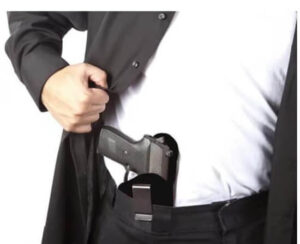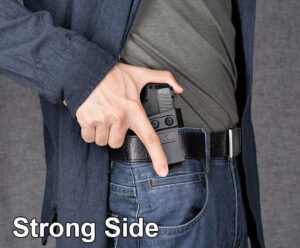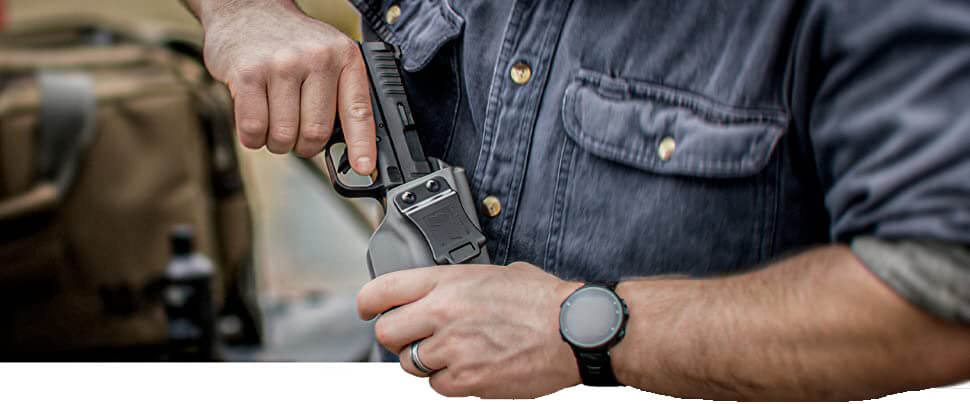Revealing the Best Carry Method: Appendix vs. Strong Side Showdown
Concealed carry has become an essential aspect of personal defense for many responsible gun owners. When it comes to carrying a concealed firearm, the method of carry plays a crucial role in accessibility, comfort, and overall effectiveness. In this article, we will explore two popular concealed carry methods: appendix vs strong side carry. By understanding the advantages and disadvantages of each method, you’ll be better equipped to make an informed decision that suits your needs and preferences.
Appendix Carry: Pros and Cons
 Appendix carry refers to carrying the firearm in front of the body, usually positioned around the front of the waistband. This method has gained popularity due to its accessibility and quick draw. When done correctly, the firearm can be easily accessed with a natural hand movement, allowing for a fast and efficient response in self-defense situations.
Appendix carry refers to carrying the firearm in front of the body, usually positioned around the front of the waistband. This method has gained popularity due to its accessibility and quick draw. When done correctly, the firearm can be easily accessed with a natural hand movement, allowing for a fast and efficient response in self-defense situations.
One of the significant advantages of appendix carry is its concealment potential. The placement of the firearm in front of the body helps minimize printing, making it easier to conceal the weapon under clothing. This can be particularly beneficial for individuals who often find themselves in social or professional settings where discretion is crucial.
Additionally, appendix carry provides excellent retention and control over the firearm. The position allows the gun to be hugged by the body, making it more difficult for an assailant to disarm you. This added control can be reassuring, especially in close-quarters confrontations where physical contact is likely.
However, it is essential to consider the potential drawbacks of appendix carry. Comfort and mobility can be a concern for some individuals, as the firearm is positioned in a sensitive area of the body. Finding the right holster and adjusting it properly can help alleviate these discomforts, but it’s crucial to prioritize personal comfort and ease of movement.
Furthermore, the proximity of the appendix carry position to the body’s centerline poses a potential risk of injury during an accidental discharge. Proper training, strict adherence to firearm safety rules, and the use of quality holsters are essential to mitigate this risk effectively.
Another consideration is the difficulty of drawing while seated, such as in a car or at a desk. The position of the holster may require extra practice and training to ensure a smooth and efficient draw, especially in confined spaces.
Strong Side Carry: Pros and Cons
 Strong side carry, also known as hip carry, refers to carrying the firearm on the dominant side of the body, typically around the waistband. This method has been widely adopted due to its comfort and natural hand positioning.
Strong side carry, also known as hip carry, refers to carrying the firearm on the dominant side of the body, typically around the waistband. This method has been widely adopted due to its comfort and natural hand positioning.
One of the primary advantages of strong side carry is the comfort it offers. With the firearm positioned on the dominant side, the weight is evenly distributed, reducing fatigue during extended periods of carry. Moreover, the natural hand positioning allows for a more relaxed draw stroke, making it easier to access the weapon when needed.
Another benefit is the better weight distribution provided by strong side carry. The firearm’s position on the hip ensures that the weight is spread across a larger area, reducing discomfort and the potential for back strain, especially when carrying heavier firearms.
Drawing from a seated position, such as in a vehicle, is generally easier with strong side carry. The position of the firearm on the dominant side allows for a more straightforward and unobstructed draw stroke, providing a potential advantage in situations where time is of the essence.
However, strong side carry does have its drawbacks. The longer draw time compared to appendix carry can be a critical factor in self-defense scenarios. Depending on the individual’s proficiency and training, the additional time required to access the firearm from the strong side could be a significant disadvantage.
Printability and visibility are also factors to consider with strong side carry. Depending on the individual’s body type, clothing choices, and holster selection, the firearm may be more prone to printing or becoming visible through clothing. This potential visibility could compromise the element of surprise, which is a crucial advantage in self-defense situations.
Limited access in close-quarters situations is another consideration. When engaged in physical contact or grappling, the strong side carry may be more challenging to access and employ effectively. It is important to train in techniques that can compensate for this limitation if strong side carry is your preferred method.
Comparison of Appendix vs Strong Side Carry
Here’s a comparison table highlighting the key differences between appendix carry and strong side carry:
| Aspect | Appendix Carry | Strong Side Carry |
|---|---|---|
| Accessibility | Quick and easy draw with a natural hand movement | Slightly longer draw time due to positioning |
| Concealment | Excellent concealment with minimal printing | Potential for printing and visibility depending on body type |
| Comfort | May cause discomfort and restricted mobility for some individuals | Generally comfortable with even weight distribution |
| Retention and Control | Offers good retention and control in close-quarters situations | Moderate retention and control may be compromised in grappling |
| Draw while Seated | Challenging drawing while seated, requires additional practice | Easier and more natural draw from seated positions |
| Draw Time | Generally faster draw time due to position and accessibility | Slightly longer draw time compared to appendix carry |
| Weight Distribution | Weight is centered in front of the body | Weight is evenly distributed on the dominant side |
| Close-Quarters Access | May be difficult to access and employ effectively in grappling | Relatively easier access in close-quarters situations |
| Printing and Visibility | Minimal printing and visibility when properly holstered | Potential for printing and visibility depending on body type |
Factors to Consider When Choosing
When deciding between appendix carry and strong side carry, several factors come into play. Body type, clothing choices, lifestyle, and daily activities all influence the suitability of a particular carry method. It is essential to choose a method that aligns with your needs and priorities.
Consider your body type and how it interacts with the chosen carry position. What works well for one person may not be as comfortable or concealable for another. Experiment with different holsters and positions to find the one that suits your body type and clothing choices best.
Your lifestyle and daily activities should also inform your carry method selection. For example, if you have a physically demanding job or frequently engage in activities that require a lot of movement, appendix carry may be less suitable due to comfort and mobility concerns.
Training and proficiency levels should never be overlooked. Whichever carry method you choose, invest time and effort in proper training to ensure safe and effective firearm handling. Seek professional instruction and practice regularly to become proficient in your chosen carry method.
Conclusion
In the end, the choice between appendix carry and strong side carry is a personal one, influenced by various factors unique to each individual. Both methods offer advantages and disadvantages that must be carefully considered. By understanding the pros and cons of each carry method and taking into account your body type, clothing choices, lifestyle, and training level, you can make an informed decision that maximizes your comfort, concealment, and overall effectiveness in carrying a concealed firearm.
Remember, the best carry method is one that suits your needs, allows for a quick and efficient draw, and ensures the safety of yourself and those around you. Choose wisely, train diligently, and stay prepared.

